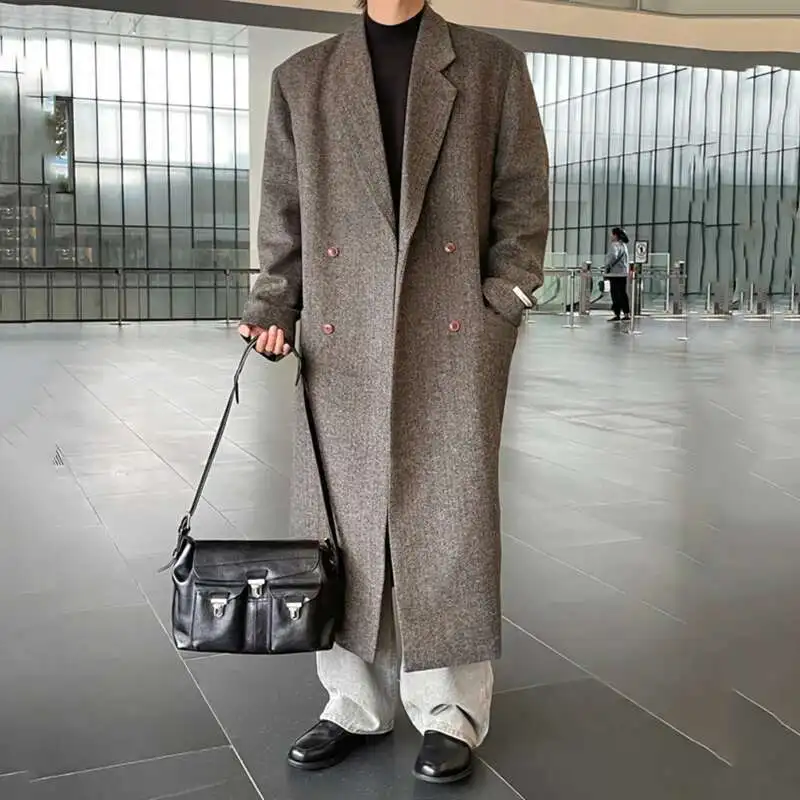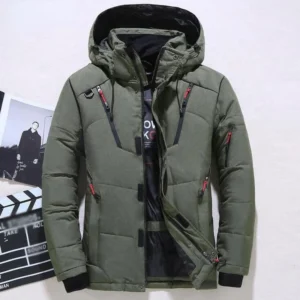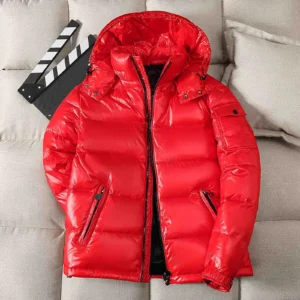Introduction: Why the Herringbone Overcoat Remains a Menswear Essential
The herringbone overcoat stands as one of menswear’s most enduring classics, immediately recognizable by its distinctive zigzag pattern that resembles the skeleton of a herring fish. This sophisticated pattern creates visual texture and dimension that elevates any winter ensemble from ordinary to extraordinary.
Dating back centuries, the herringbone weave first gained prominence in luxury tailoring circles of Britain before becoming a worldwide symbol of refined taste. What began as a practical fabric choice valued for its durability has evolved into a style statement that transcends passing trends.
What makes the men’s herringbone coat truly special is its remarkable versatility. Few garments can transition so effortlessly between formal business settings and casual weekend outings. This adaptability, combined with exceptional durability and timeless appeal, explains why style-conscious men consider it not merely a purchase but an investment in their wardrobe.
In this comprehensive guide, we’ll explore everything from selecting your ideal herringbone pattern and fit to styling techniques for any occasion. Whether you’re considering your first herringbone acquisition or looking to maximize one already hanging in your closet, you’ll discover how this classic piece remains perpetually relevant in modern men’s fashion.
Understanding Herringbone Pattern: What Makes It Distinctive and Timeless
The herringbone pattern derives its name from its resemblance to a fish skeleton, with rows of parallel lines that create a distinctive V-shaped zigzag effect. Unlike its close relatives in the pattern family, herringbone has unique characteristics that set it apart. While tweed refers to a rough-textured wool fabric often featuring various patterns, and houndstooth creates a broken checkered effect, herringbone features clean, continuous diagonal lines that reverse direction to create its signature V-formation.
What makes herringbone particularly special is the visual depth it creates. The alternating diagonal lines catch light differently, producing subtle dimension and movement that plain fabrics simply cannot achieve. This textural interest allows the pattern to make a sophisticated statement without being flashy or overwhelming.
The pattern can range from micro-herringbone, where the design is barely perceptible from a distance, to bold, pronounced versions that make a stronger visual statement. This versatility in scale has helped the pattern understanding herringbone coat pattern remain relevant across decades of changing fashion sensibilities. The herringbone weave adds character and refinement to an overcoat without sacrificing its classic appeal, making it both interesting enough to stand out and subtle enough to remain eternally stylish.
Selecting Your Ideal Herringbone Overcoat: Key Considerations
Finding your perfect herringbone overcoat requires attention to several important details that affect both style and functionality:
Pattern Scale: The size of the herringbone pattern dramatically impacts the coat’s overall appearance. Micro-patterns create a more subtle, refined look that appears almost solid from a distance – ideal for formal settings. Medium-scale patterns offer versatility for both business and casual wear. Large, bold herringbone makes a stronger statement and works well for standout pieces in your wardrobe.
Color Selection: While best colors herringbone coats traditionally come in neutral tones, each shade creates a different effect. Charcoal gray offers maximum versatility and formal appeal. Mid-gray provides balance between formal and casual. Light gray creates a distinctive look that pairs beautifully with navy and burgundy. Brown herringbone delivers rich, warm elegance with vintage appeal. For contemporary interpretations, consider navy or dark green versions that maintain the classic appeal with a fresh perspective.
Material Quality: Pure wool remains the gold standard for herringbone overcoats, offering natural insulation, breathability, and a beautiful drape. Wool blends (often with small percentages of synthetic fibers) can add durability and wrinkle-resistance. Luxury options include cashmere or cashmere-wool blends that provide exceptional softness and lightweight warmth, though at a premium price point.
Weight and Seasonality: Fabric weight significantly impacts when and where you can wear your coat. Heavyweight options (24-28 oz) provide superior warmth for genuine winter conditions. Medium-weight options (20-24 oz) offer versatility for most cold-weather situations. Lightweight versions (18-22 oz) work well for transitional seasons or milder climates.
When investing in a quality herringbone overcoat, prioritize the factors most important to your climate and lifestyle needs. A well-chosen coat can provide decades of service while maintaining its distinguished appearance.
Finding Your Perfect Fit: A Guide to Herringbone Overcoat Silhouettes
The fit of your herringbone overcoat fundamentally determines both its comfort and style impact. Understanding key fit considerations helps ensure your investment provides both aesthetic appeal and practical function:
Classic Tailored Fit: The traditional approach features a structured shoulder, moderate room through the chest and body, and a clean drape. This timeless silhouette accommodates layering while maintaining a refined appearance. Ideal for professional settings and formal occasions, it flatters most body types and remains stylistically relevant regardless of trend cycles.
Modern Slim Fit: Contemporary interpretations feature narrower shoulders, a trimmer chest and waist, and often slightly higher armholes. This sleeker profile creates a more fashion-forward appearance but may limit heavy layering options. Best for those with slim-to-athletic builds who prioritize a streamlined aesthetic.
Relaxed/Oversized Fit: Currently trending, this style features dropped shoulders, generous room throughout, and often a longer length. It creates a casual, effortless vibe while allowing maximum layering. This dramatic silhouette makes a bolder statement and works particularly well in creative environments.
Regardless of your preferred silhouette, proper fit indicators include: shoulder seams that align with your natural shoulder edge, sleeves that allow 1/4-1/2 inch of shirt cuff visibility, and sufficient room to comfortably layer without restriction. The choosing right coat length depends on both proportion and practical considerations – knee-length provides maximum protection and formal elegance, while mid-thigh lengths offer versatility and ease of movement.
For most men, mens coat length guide suggests the ideal coat should end somewhere between mid-thigh and just above the knee, depending on your height and the coat’s intended formality. Remember that alterations can often perfect the fit of an otherwise ideal coat, particularly in sleeve length and sometimes body circumference.
Business and Formal Attire: Commanding Professional Presence
The herringbone overcoat truly shines in professional and formal environments, where its structured elegance complements tailored clothing perfectly. In business settings, this distinguished overcoat immediately communicates attention to detail and classic good taste.
When pairing with suits, coordination rather than matching should be your goal. A gray herringbone overcoat creates a powerful pairing with navy or charcoal suits – the pattern adding visual interest while the neutral color ensures harmony. For a sophisticated business ensemble, try a mid-gray herringbone coat over a navy wool suit, crisp white shirt, and burgundy tie, finished with black Oxford shoes. This combination balances professionalism with subtle style through textural contrast.
For formal evening occasions, a charcoal herringbone coat makes an excellent companion to black tie attire, offering protection from the elements without sacrificing elegance. Layer it over a black suit with a white dress shirt and black tie, completing the look with well-polished black dress shoes. The textural interest of the herringbone provides a refined contrast to the sleekness of formal wear.
When wearing over structured pieces like suits, proportion becomes particularly important. Ensure your overcoat is sufficiently sized to accommodate suit jackets without pulling or restriction across the shoulders or chest. The coat’s length should complement the suit beneath – traditionally extending slightly beyond suit jacket length for proper coverage and visual balance.
Business-appropriate accessories elevate these pairings further. Consider leather gloves in black or brown depending on your footwear, a cashmere scarf in a complementary solid color, and a structured leather briefcase or document holder. These finishing touches reinforce the coat’s formal character while adding functional elegance to your professional appearance.
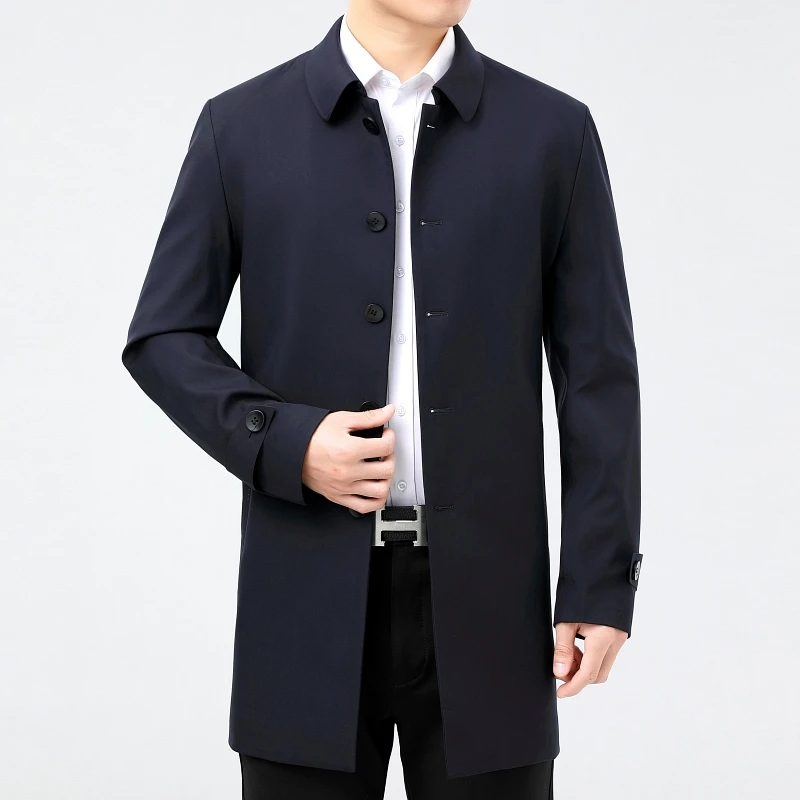
Smart Casual Combinations: Versatile Weekday Styling
The herringbone overcoat truly demonstrates its versatility in smart casual settings, where it adds refinement to more relaxed ensembles. This middle ground between formal and casual dressing offers perhaps the widest range of styling possibilities.
For a polished office-appropriate look that doesn’t require a full suit, pair your mens wool overcoat in herringbone with thoughtfully selected separates. Try a brown herringbone coat over a navy blazer with medium gray flannel trousers, light blue oxford cloth button-down, and brown suede Chelsea boots. This combination offers professional appropriateness with greater comfort and individual expression than traditional suiting.
Knitwear creates particularly harmonious pairings with textured herringbone. A charcoal herringbone coat layered over a rich burgundy merino turtleneck with dark wash jeans and black leather Chelsea boots creates a sophisticated yet approachable appearance suitable for creative offices, dinner dates, or cultural outings. The turtleneck adds warmth while creating a clean, minimal look that lets the coat’s pattern take center stage.
For slightly more casual environments, consider a gray herringbone overcoat with olive chinos, a cream cable-knit sweater, and brown leather loafers. This combination balances the coat’s formality with more relaxed elements while maintaining an intentional, put-together appearance.
Footwear choices significantly influence the overall effect of these smart casual combinations. Chelsea boots in leather or suede strike an ideal balance of refinement and ease. Quality derby shoes or loafers maintain polish while appearing less formal than traditional Oxfords. For the most casual interpretation, clean, minimal sneakers in white or earth tones can work beautifully, especially with darker herringbone patterns.
Weekend and Casual Styling: Elevating Off-Duty Looks
The true mark of a versatile wardrobe piece is its ability to transcend obvious settings, and the herringbone overcoat excels at elevating casual weekend attire. By pairing this traditionally formal garment with deliberately relaxed pieces, you create an appealing style contrast that appears both thoughtful and effortless.
Denim forms a particularly effective foundation for casual herringbone styling. A gray herringbone overcoat paired with dark indigo jeans creates a pleasing contrast of formality levels. Add a black hoodie underneath and clean white sneakers to complete a sophisticated weekend look that balances comfort with style. The structured coat elevates these casual elements while the relaxed components make the coat feel less business-oriented.
For a rugged yet refined approach, combine a brown herringbone overcoat with a denim or chambray shirt, black jeans, and brown leather boots. This combination nods to workwear influences while maintaining an elevated appearance. The textural interplay between the herringbone pattern and denim creates visual interest without requiring bold colors or accessories.
Another effective weekend formula pairs a charcoal herringbone coat with a simple gray sweatshirt, quality indigo selvedge denim, and suede desert boots. This approach creates a comfortable yet considered appearance perfect for weekend brunches, casual gatherings, or art gallery visits.
Casual accessories should maintain the balanced approach. Consider trading formal leather gloves for knitted ones, swapping a dress scarf for a chunkier knit version, and choosing a casual beanie rather than a formal hat. A canvas and leather messenger bag or weekend duffle complements this aesthetic better than structured briefcases or document holders. These thoughtful adjustments maintain cohesion between the coat and its more relaxed accompanying elements.
Mastering Color Coordination: Creating Cohesive Looks
Effective color coordination transforms good outfits into great ones, particularly when working with a statement piece like a herringbone overcoat. Understanding how to build harmonious color combinations around your coat creates nearly endless styling possibilities.
First, identify the dominant color tones in your herringbone pattern. Most herringbone coats feature a blend of two similar shades creating the pattern effect. These base colors become your starting point for building coordinated looks.
For mens grey overcoat options in herringbone, certain color families create particularly effective combinations:
– Navy blues complement gray beautifully, creating a classic pairing with enough contrast for visual interest
– Burgundy and wine tones add rich accent color that balances gray’s neutrality
– Forest and olive greens create sophisticated, understated combinations
– White and cream provide crisp contrast, particularly effective with darker gray herringbone
Brown herringbone coats harmonize with different complementary palettes:
– Navy remains effective but creates a warmer overall effect than with gray
– Mustard and amber tones create rich seasonal combinations
– Cream and ivory soften the overall look with elegant contrast
– Olive and sage greens create natural-feeling color harmony
For the most sophisticated approach, consider monochromatic or tonal outfits where all elements fall within the same color family at varying intensities. A gray herringbone coat with charcoal trousers, a lighter gray sweater, and white shirt creates subtle sophistication through textural variation rather than color contrast.
Seasonal considerations also influence optimal color choices. In fall and winter, richer, deeper tones like burgundy, forest green, and navy create seasonally appropriate combinations. Spring transitions might incorporate lighter blues, tans, and softer neutrals while maintaining harmony with your herringbone pattern.
Expert Layering Techniques: Warmth with Style
Mastering the art of layering with a herringbone overcoat ensures both practical warmth and visual sophistication. Strategic layering transforms your coat from merely outerwear into the centerpiece of a thoughtfully constructed ensemble.
Start with consideration of base layers. Lightweight merino wool or quality cotton garments provide temperature regulation without adding bulk. These thin, close-fitting layers trap body heat effectively while allowing freedom of movement. For formal settings, a quality dress shirt serves as both presentation layer and thermal foundation. For casual contexts, fine merino t-shirts or lightweight cotton henleys provide warmth without thickness.
Mid-layers create both insulation and style opportunity. Fine gauge knitwear in merino, cashmere, or quality cotton adds substantial warmth without excessive bulk. Consider these effective mid-layer combinations:
– Thin merino turtleneck under a tailored suit creates a sophisticated alternative to shirt and tie
– Cashmere V-neck sweater over a dress shirt adds insulation while maintaining a refined appearance
– Lightweight wool vest provides core warmth while allowing unrestricted arm movement
– Quarter-zip pullover creates a casual yet put-together mid-layer option
Managing bulk maintains the clean lines of your herringbone coat. Choose thinner, denser fabrics rather than thick, fluffy ones for layers that provide warmth without excessive volume. Pay particular attention to shoulder and arm fit – excess fabric here quickly creates an uncomfortable, restricted feeling when layered under a coat.
Textural variation enhances layered outfits visually. Combine different fabric textures – the rough texture of herringbone wool against smooth merino, ribbed knitting, or crisp cotton – to create subtle dimensional interest in your ensemble. This approach maintains visual engagement even when working within a limited color palette.

Essential Accessories: Completing Your Herringbone Look
The right accessories not only enhance the functionality of your herringbone overcoat but also serve as strategic style elements that complete your overall appearance. Thoughtful accessory selection transforms good outfits into memorable ones.
Scarves provide both practical warmth and styling opportunity. For formal settings, consider fine wool or cashmere scarves in solid colors or subtle patterns that complement your coat’s tone. Burgundy, navy, and forest green work beautifully with gray herringbone, while camel, rust, and deep blue complement brown herringbone patterns. The way you wear your scarf matters too – a clean, symmetrical drape for business settings versus a more casual, wrapped approach for weekend wear.
Gloves should balance protection with refinement. Leather gloves in black or dark brown provide classic elegance for formal settings. For smart casual combinations, consider suede options in colors that complement your overall palette. Knitted gloves in wool or cashmere offer more casual alternatives for weekend styling. The most versatile choice combines both approaches – leather outer with knitted lining.
Headwear should respect the formality of your overall outfit. With business attire, consider classic felt hats like fedoras or trilbys in colors that complement your coat. For casual styling, wool beanies or flat caps provide character while maintaining cohesion with the short vs long coats guide principles of proportion and balance.
Your choice of bag significantly impacts your overall appearance. For business settings, structured leather briefcases or document holders maintain formal integrity. For daily commuting, consider leather messenger bags or sleek backpacks in materials that echo the refinement of your coat. Weekend excursions call for casual leather or canvas duffle bags or totes that balance practicality with style.
Small accessories add final refinement – a simple, elegant watch, quality leather belt that matches your shoes, and minimal metallic elements like tie bars or cufflinks for formal settings complete a thoughtfully assembled appearance.
Seasonal Adaptability: Year-Round Styling Approaches
While traditionally associated with winter, a herringbone overcoat can serve your wardrobe across more seasons than you might expect. Understanding seasonal adaptation extends the usability of this investment piece throughout changing weather conditions.
Early fall presents perfect conditions for lightweight herringbone styling. As temperatures begin to cool, layer your coat over light merino sweaters or cotton shirts without heavy insulating layers. This approach provides just enough warmth for crisp mornings and evenings while avoiding overheating during warmer daytime hours. Color choices in early fall can incorporate richer earth tones – olive chinos, burgundy accessories, or amber knitwear – that complement the seasonal transition.
Deep winter requires maximizing the coat’s protective qualities. Embrace comprehensive layering with thermal base layers, substantial wool or cashmere sweaters, scarves, hats, and gloves. Consider how these practical additions can maintain style coherence – matching leather gloves to boots, coordinating scarf patterns with subtle elements in your outfit, selecting hats that complement your face shape and overall aesthetic.
Early spring transitions call for gradually lightening your approach. Return to single mid-layers, perhaps switching from heavy wool sweaters to cotton shirts or lightweight cardigans. Color palettes can shift toward slightly brighter tones while maintaining coordination with your coat’s pattern. This season particularly benefits from adaptable layering that can be adjusted throughout the day as temperatures fluctuate.
Mens winter coats in herringbone patterns particularly excel at handling variable conditions within the same day. During unpredictable transitional weeks, prepare for temperature swings by focusing on adaptable layers underneath that can be added or removed as needed while your coat provides consistent outer protection and style.
Mens Heavy Winter Coat, Mens Insulated Coat, Mens Parka Coat
Price range: $175.52 through $237.36 Select options This product has multiple variants. The options may be chosen on the product pageMens Big and Tall Winter Coats, Mens Down Coat, Mens Hooded Winter Coat, Mens Puffer Coat
Price range: $126.44 through $217.01 Select options This product has multiple variants. The options may be chosen on the product pageMens Big and Tall Winter Coats, Mens Hooded Winter Coat
Price range: $80.32 through $106.68 Select options This product has multiple variants. The options may be chosen on the product pageMens Cashmere Overcoat, Mens Hooded Winter Coat, Mens Wool Blend Coat
Price range: $128.72 through $139.68 Select options This product has multiple variants. The options may be chosen on the product pageMens Hooded Winter Coat, Mens Insulated Coat, Mens Puffer Coat, Mens Quilted Coat
Price range: $139.88 through $177.72 Select options This product has multiple variants. The options may be chosen on the product pageMens Black Overcoat, Mens Black Wool Coat, Mens Wool Overcoat
$339.18 Select options This product has multiple variants. The options may be chosen on the product page
Care and Maintenance: Ensuring Longevity of Your Investment
A quality herringbone overcoat represents a significant investment that, with proper care, can provide decades of service while maintaining its distinguished appearance. Implementing simple maintenance routines protects this investment and ensures your coat continues to make a positive impression.
Between wearings, always hang your coat on a sturdy, broad-shouldered wooden or padded hanger that maintains its shape. Allow the coat to air out for at least 24 hours between wearings to release moisture and restore the fabric’s natural resilience. For daily maintenance, use a soft clothes brush to remove surface dust and debris, brushing gently in the direction of the herringbone pattern.
Professional cleaning should be approached judiciously. Most wool overcoats benefit from limited dry cleaning – typically once at the end of the winter season before storage, or more frequently only if visibly soiled. Excessive dry cleaning can break down wool fibers and remove natural oils that contribute to the fabric’s performance. Between cleanings, spot-treat minor stains using a damp cloth and mild soap, blotting rather than rubbing.
For seasonal storage, ensure the coat is professionally cleaned, then store in a breathable garment bag (avoid plastic) with cedar blocks or other natural moth deterrents. Store in a cool, dry place away from direct sunlight, which can fade the fabric over time.
Address minor issues promptly to prevent them from worsening. Loose threads should be carefully trimmed rather than pulled. Small areas of pilling can be gently removed with a fabric shaver or sweater stone. Minor tears or loose buttons warrant professional repair to maintain the coat’s integrity and appearance.
Signs that indicate professional attention include lingering odors that don’t dissipate with airing, persistent stains, significant wrinkles that don’t hang out, or any structural damage to seams or lining. Investing in timely professional care prevents minor issues from becoming major problems.
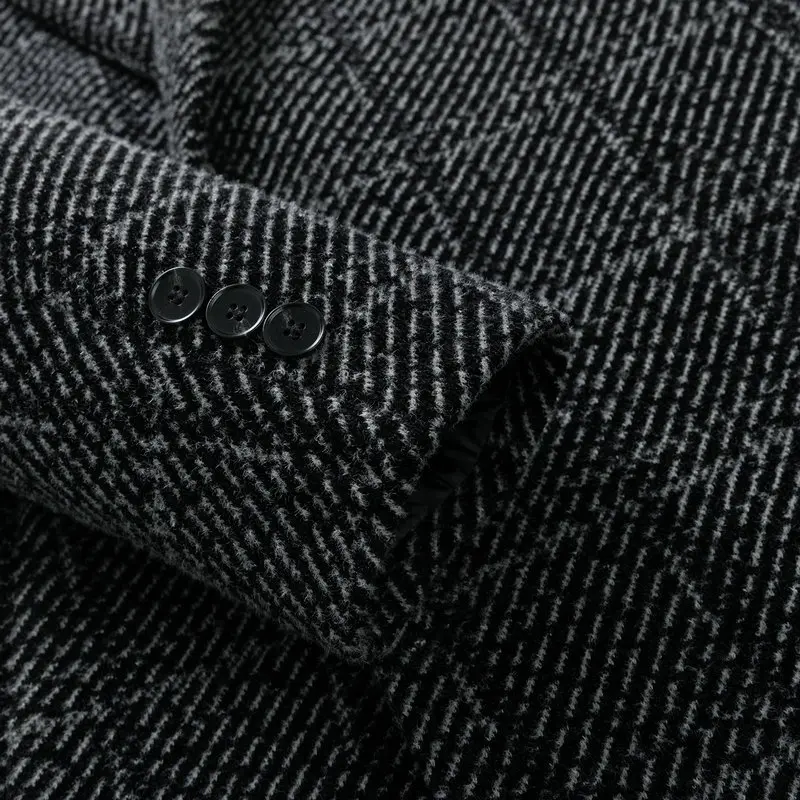
Questions About Herringbone Overcoats: Expert Answers
Is a herringbone overcoat formal or casual?
A herringbone overcoat occupies a versatile middle ground that allows it to move between formality levels. In traditional neutral colors with classic tailoring, it pairs perfectly with formal business attire and even black tie events. However, the textural interest of the pattern also allows it to complement smart casual and even casual weekend outfits when styled appropriately. This adaptability makes it an exceptionally valuable wardrobe investment.
How should a herringbone overcoat fit across the shoulders?
The shoulder seams of your herringbone overcoat should align with your natural shoulder edge or extend just slightly beyond it. This provides a clean, tailored appearance while allowing comfortable movement and sufficient room for layering. Excessively wide shoulders create a sloppy, oversized appearance, while overly narrow shoulders restrict movement and create uncomfortable pulling when layered over jackets or knitwear.
Can you wear herringbone with other patterns?
Yes, herringbone can be successfully combined with other patterns by following the principle of scale variation. When wearing herringbone plaid coat patterns together, ensure each pattern is a distinctly different size. For instance, a herringbone overcoat works beautifully with a micro-check shirt and a larger scale plaid tie, or with a pinstripe suit and solid accessories. This scale differentiation prevents patterns from competing visually.
What’s the difference between tweed and herringbone?
Herringbone describes a specific zigzag pattern created by the arrangement of threads, while tweed refers to a rugged wool fabric that may incorporate various patterns, including herringbone. Put simply: herringbone is a pattern, while tweed is a fabric type. You can find herringbone patterns in many materials beyond tweed, including fine worsteds and cashmere blends, just as tweed fabrics come in many patterns beyond herringbone.
Are herringbone overcoats worth the investment?
Quality herringbone overcoats represent excellent value despite their initial cost. Their classic pattern remains stylistically relevant regardless of fashion trends, while the typically high-quality wool construction offers exceptional durability and aging characteristics. The versatility to move between formal and casual contexts further enhances their practicality. With proper care, a well-made herringbone overcoat can provide decades of service while maintaining its distinguished appearance.
The Herringbone Overcoat in Contemporary Fashion: Modern Interpretations
While herringbone overcoats boast impressive heritage, they continue to evolve through contemporary reinterpretations that keep them relevant for modern wardrobes. Today’s designers balance respect for tradition with fresh perspectives that appeal to current tastes.
Modern herringbone coats often feature updated proportions that reflect today’s preferences. Slightly shorter lengths (typically hitting mid-thigh rather than below the knee) create a more versatile piece that works as well with jeans as with suits. Slimmer, more defined silhouettes reflect contemporary tailoring trends while maintaining the coat’s distinguished character.
Designers have also refreshed traditional herringbone patterns through thoughtful innovations. Some offer higher-contrast color combinations that make the pattern more pronounced, while others opt for subtler, muted versions for understated elegance. Contemporary mens tweed coat options might feature unexpected color undertones – hints of burgundy, forest green, or even subtle blue threads woven into otherwise traditional patterns.
Construction details have likewise evolved. Modern versions might incorporate practical elements like hidden smartphone pockets, removable throat latches, or water-resistant treatments that enhance functionality without compromising aesthetic appeal. Technical fabric blends that add performance characteristics like stretch, water-resistance, or enhanced insulation represent another contemporary innovation.
Style influencers have embraced creative styling approaches that breathe new life into this classic piece. High-low combinations pairing formal overcoats with athletic-inspired components create striking contemporary looks. Monochromatic styling that builds entire outfits in varying shades of a single color family offers sophisticated minimalism. Unexpected color combinations – rich burgundy accessories with gray herringbone, or mustard accents with brown patterns – create distinctive seasonal statements.
Final Thoughts: Embracing the Versatility of Your Herringbone Overcoat
The enduring appeal of the herringbone overcoat lies precisely in its remarkable versatility. Few garments successfully bridge formal business environments and casual weekend settings while maintaining their distinctive character and sophistication across contexts.
As you incorporate a herringbone overcoat into your wardrobe, remember that experimentation reveals its true potential. Try unexpected combinations – formal with casual, structured with relaxed, traditional with contemporary – to discover the full range of possibilities this classic garment offers. The subtle texture and pattern provide a perfect foundation for expressing personal style while maintaining timeless good taste.
When selecting your ideal herringbone piece, prioritize quality construction, proper fit, and a pattern scale that aligns with your typical clothing choices. These fundamental considerations ensure your investment provides maximum versatility and longevity. With appropriate care, this distinguished garment will remain a cornerstone of your cold-weather wardrobe for many seasons to come, developing character and personal history with each wearing.
The herringbone overcoat represents the perfect balance of practical function and refined aesthetic – a rare combination that explains its enduring appeal among men who value both style and substance in their wardrobe investments.

